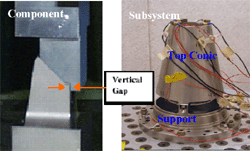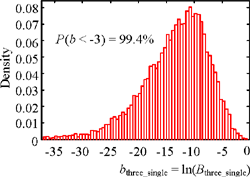 |
 |
|
Inclined lap joint test set up
(http://infoserve.sandia.gov) |
Probabilistic assessment of the three-leg
joint model using single-leg data |
Overview: Vanderbilt University is developing computational methods to quantify physical, informational, and model uncertainties in design and certification analyses of complex engineering systems, funded by Sandia National Laboratories, under the Sandia/NSF Life Cycle Engineering Program. Assumptions and approximations during modeling and simulation induce error in the model prediction. Therefore, the model needs to be verified and validated to be able to use it for future applications. Verification and validation under uncertainty involves quantifying various errors and comparing model predictions with experimental data when both are uncertain. For large systems involving subsystems and components, the validation information at component-level could be used to make inference at system-level where full scale test data is not available. Bayesian networks are employed to propagate information within the system. Ultimately, the inferences made in the validation domain need to be extrapolated to the untested region where the actual application takes place.
The techniques being proposed so far are:
Example Application: These methods and techniques have been implemented to a wide range of spatial and temporal examples ranging from basic material yielding models to dynamic system reliability models, including the three challenging model validation problems provided by Sandia. Particularly, a practical problem involving mechanical properties of joints and their structural response under dynamic loading is considered. A hierarchical approach integrating Bayesian network, structural equation modeling and Bayesian hypothesis testing is developed to validate the three-leg joint model (subsystem level) using single-leg data (component level).
 |
 |
|
Inclined lap joint test set up
(http://infoserve.sandia.gov) |
Probabilistic assessment of the three-leg
joint model using single-leg data |
Potential Applications: Verification and validation (V&V) of engineering systems has a wide range of applications in industrial settings, in improving the reliability of the computational models, and managing uncertainties in decision making processes. V&V is increasingly playing a major role in the certification and accreditation process complex systems in NASA, DOE, and DOD.
Selected References: The Vanderbilt research has been documented in over 10 journal papers so far.
©